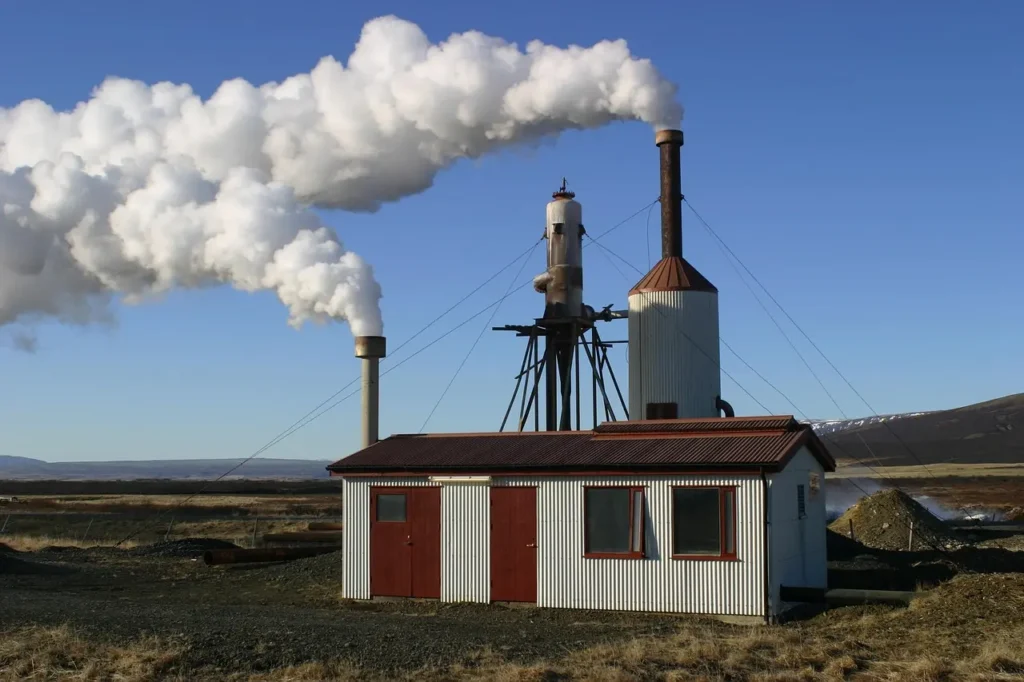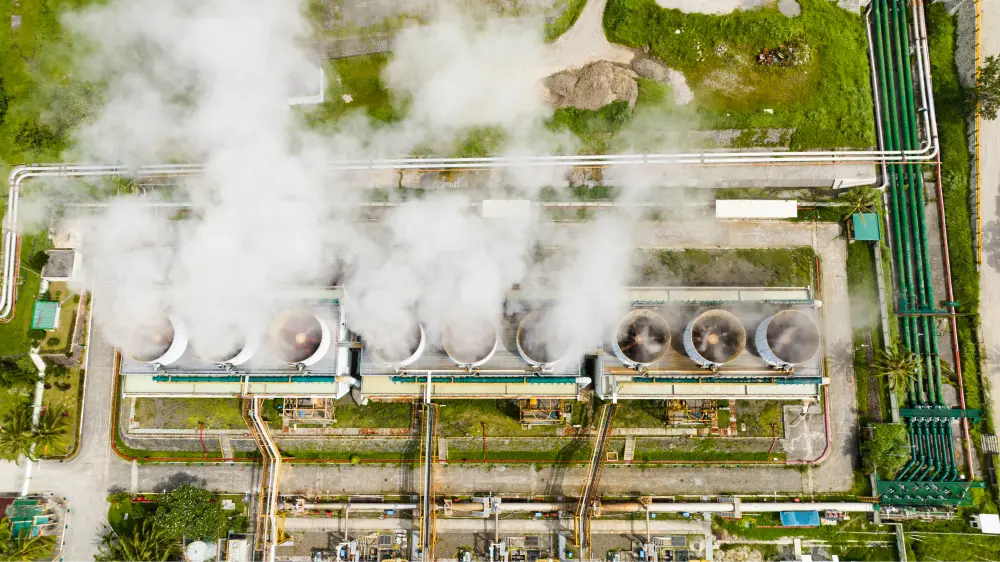How Many Geothermal Power Plants in Texas?
3 minute readAnalysis of geothermal development in Texas through 2025. From pilot projects to legislative trends and future potential.
Home > Learning Center > Energy Production > Environmental Impact of Geothermal Energy
Uncover the environmental impact of geothermal energy, from low emissions to pollution risks and seismic concerns. Learn how geothermal stacks up as a clean energy source.
4 minute read • Last update June 2025

The environmental impact of geothermal energy is generally positive, as it’s a clean, reliable renewable resource that uses the Earth’s natural heat to generate low-emission power. However, it does come with trade-offs, including water consumption, land use, and the risk of induced seismicity. Below, we break down 10 key ways geothermal energy affects the environment.
Geothermal power plants emit significantly fewer greenhouse gases than fossil fuel plants. The primary emissions include carbon dioxide, methane, and hydrogen sulfide, which are minimal and often captured and reinjected into the earth.
For example, systems like CarbFix at the Hellisheiði plant in Iceland sequester roughly 34% of CO₂ and 60% of H₂S emissions. According to life-cycle emissions data from NREL, geothermal energy produces just 38–45 g CO₂e per kWh, on par with wind and significantly lower than solar PV.
Although emissions are low, does geothermal energy cause pollution? In some cases, yes. During drilling or operation, geothermal fluids can bring up trace amounts of harmful substances like arsenic, mercury, or boron.
Proper management and reinjection systems are critical to prevent groundwater contamination. For instance, studies show geothermal fluids often contain arsenic, mercury, and boron, which can damage local waterways and ecosystems if not contained. High concentrations of these elements have been found contaminating aquifers near geothermal plants, until reinjection practices were enforced to mitigate the risk.
Geothermal plants, especially flash steam systems, require significant water for cooling and reinjection. In water-scarce regions, this can put additional pressure on local resources. Closed-loop or binary systems use less water to mitigate this issue.
Drilling deep into the Earth and altering underground pressure can trigger minor earthquakes, a phenomenon known as induced seismicity. These events are usually low in magnitude but can still cause concern in nearby communities. Thorough site assessments and continuous monitoring are essential to help mitigate the risk.
Compared to wind or solar farms, geothermal plants occupy significantly less surface area. For example, Austin Energy’s 5 MW geothermal pilot near Austin is being developed on a compact site with most of the infrastructure, such as wells and piping, located underground.
Similarly, a closed-loop geothermal test well near Houston reaches depths of over 11,000 feet while requiring only a minimal surface footprint. This smaller land requirement makes geothermal especially well-suited for space-constrained or urban areas in Texas.
While the above-ground impact is modest, construction still disrupts land and ecosystems. Access roads, drilling pads, and pipelines can fragment habitats.
Drilling phases can be noisy, and operational equipment such as cooling towers and steam vents may generate continuous sound during plant operation. According to the EPA’s Schiller Station environmental report, cooling towers can contribute to elevated ambient noise levels, particularly when operating near residential or sensitive areas.
While the visual impact of geothermal facilities is generally minimal due to their compact footprint, early and ongoing community engagement is essential to address potential concerns related to noise, aesthetics, and site activity.
Overproduction of geothermal fluids can deplete underground reservoirs. This leads to surface subsidence and a decline in energy output. Subsidence occurs when excessive fluid extraction causes pressure loss and compaction of underground formations, potentially resulting in property damage and regulatory claims.
To prevent these outcomes, sustainable geothermal operations continuously monitor reservoir pressure and temperature, reinject fluids to maintain equilibrium, and balance extraction rates to support long-term resource viability.
Unlike wind and solar farms, geothermal energy delivers consistent baseload power 24/7, reducing dependence on fossil-fueled peaker plants and improving grid stability. This around-the-clock reliability helps stabilize the grid by adding weight to the center of the load curve, minimizing fluctuations caused by intermittent renewables. As a result, geothermal reduces the need for carbon-intensive backup systems and supports broader decarbonization goals.
Cement, steel, and drilling fluids used in geothermal construction generate emissions and waste. While relatively minor compared to fossil fuels, these upstream activities still factor into geothermal energy’s total environmental impact.
Not in the traditional sense. Whether geothermal energy causes pollution largely depends on how the system is designed. Most modern geothermal plants operate with low emissions and use reinjection systems to prevent pollutants from entering the environment.
In contrast, older or poorly managed facilities may allow geothermal brine to release harmful elements into the soil or water. Closed-loop systems eliminate this risk entirely by circulating fluids in a sealed system with no discharge.
Geothermal energy supports stable, long-term employment across sectors such as drilling, engineering, plant operations, and maintenance. These projects also generate local tax revenue and help diversify regional energy portfolios, particularly in geologically active areas.
In Texas, the most promising geothermal resources are found in West Texas, especially within the Permian Basin and Trans-Pecos regions, where deep subsurface heat and existing oil and gas infrastructure provide ideal conditions for development. Although upfront capital requirements are high, geothermal systems offer some of the lowest operating costs in the power generation industry, making them an increasingly viable long-term investment.
Emerging technologies like Enhanced Geothermal Systems (EGS) and supercritical geothermal are expanding the reach of geothermal power beyond traditional hot spots. Policy incentives, tax credits, and growing private investment are accelerating development. In Texas, recent studies suggest geothermal could play a larger role in diversifying ERCOT’s renewable energy mix.
Texas has vast untapped geothermal potential, particularly in West Texas, where oil and gas expertise can be leveraged for geothermal exploration. As the state balances grid reliability, water conservation, and emissions reductions, geothermal energy could emerge as a strategic addition to Texas’s energy future.
Graham Lumley, Digital Marketing Manager at BKV Energy, leads digital and traditional marketing strategies, focusing on educating Texans about the state's deregulated energy market. With over 8 years of marketing experience, he creates content to help consumers understand and save on their energy bills, bringing a fresh and dynamic approach to the industry.

Analysis of geothermal development in Texas through 2025. From pilot projects to legislative trends and future potential.

Is geothermal energy renewable or nonrenewable? Geothermal energy is renewable energy that utilizes heat from beneath the Earth’s surface. Heat
Get $50 off your electric bill!
Use code BKVEJOINUS50
Enter your zip code to shop BKV Energy's affordable, fixed-rate Texas electricity plans. Use the promo code for $50 off your electric bill.